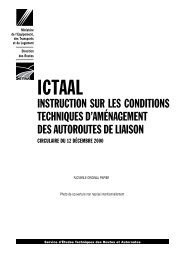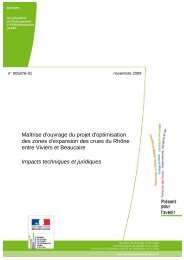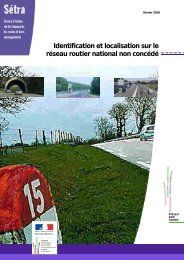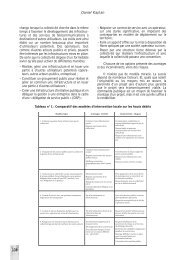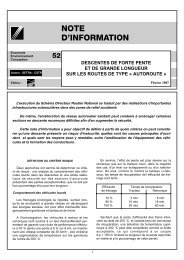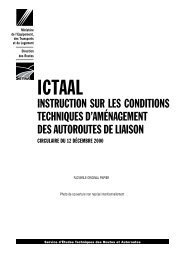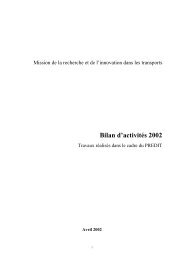des tic et des territoires - Portail documentaire du ministère de l ...
des tic et des territoires - Portail documentaire du ministère de l ...
des tic et des territoires - Portail documentaire du ministère de l ...
Create successful ePaper yourself
Turn your PDF publications into a flip-book with our unique Google optimized e-Paper software.
Telework in the scenarios for the future of work<br />
If the distance working companies are clearly a<br />
form of telework that is doing well, there are two<br />
d<strong>et</strong>erminant criteria in the growth of “telemediated”<br />
services and the location of distance working companies:<br />
less expensive labour and the performance of<br />
communications. For instance, call centres are flourishing<br />
in Ireland, where wage costs are 50% lower<br />
than in Germany, taxation of companies is one of<br />
the lowest in Europe, communications rates are<br />
<strong>de</strong>creasing with the volume of calls and population<br />
is traditionally cosmopolite [Cornford & al., 1996].<br />
Mobile Telework<br />
Mobile telework is another growing form of<br />
telework. It mostly concerns executives, itinerant<br />
commercial employees and maintenance technicians.<br />
Today it is exploiting all the potential of<br />
portable computers and data transmission n<strong>et</strong>works,<br />
so that a growing portion of tasks can be carried<br />
out at a distance, in other words, anywhere – in<br />
a client’s premises, at home, in a subsidiary, at a colleague’s<br />
home or even in the train or a hotel room.<br />
Mobile technologies favour greater geographic<br />
mobility.<br />
Unlike isolated experiments of home-based<br />
telework, mobile telework concerns large categories<br />
of employees, mainly “field workers” such as controllers,<br />
technicians and sales personnel. In the long<br />
run, it reflects a <strong>de</strong>ep-rooted reorganisation of the<br />
commercial function and the maintenance function<br />
in companies.<br />
The expansion of mobile telework, as opposed<br />
to “se<strong>de</strong>ntary” telework (at home or in a telecentre)<br />
is the illustration of exploitation of communication<br />
technologies and portable computers serving new<br />
types of organisation: just-in-time, flexible management,<br />
<strong>et</strong>c. In management terms, the objective of<br />
telework is to s<strong>et</strong> up more flexible organisational<br />
m<strong>et</strong>hods which can react more quickly, to seek b<strong>et</strong>ter<br />
organisational pro<strong>du</strong>ctivity [Carré & Craipeau,<br />
1997].<br />
Mixed Telework<br />
Beyond the personnel concerned by the new<br />
requirements of mobility, the most common form<br />
of distance working today is also the most atypical:<br />
a few hours per week at home, a few hours on the<br />
road or in the field, a few hours with clients, but the<br />
main reference is still the office and colleagues. This<br />
type of working organisation concerns not only<br />
executives, researchers, journalists, graphic artists,<br />
but also a growing number of qualified employees<br />
confronted with the constraints and requirements of<br />
flexibility.<br />
Many companies now offer a home computer<br />
to their staff members, som<strong>et</strong>imes without a specific<br />
project in mind, but always with an i<strong>de</strong>a of trig-<br />
gering new dynamics in the use of computers and<br />
n<strong>et</strong>works. This is a significant evolution in relations<br />
b<strong>et</strong>ween the professional sphere and the private<br />
sphere.<br />
Mixed telework is not an exclusive category,<br />
because it can cover telework from home, mobile<br />
telework or <strong>de</strong>centralised telework. What characterises<br />
mixed telework is the fact that it covers a vari<strong>et</strong>y<br />
of arrangements, and it changes to me<strong>et</strong> the circumstances<br />
and needs. The result is often a compromise<br />
b<strong>et</strong>ween the pressure exercised by companies<br />
for greater flexibility of their executives and skilled<br />
employees on one hand, and those persons’ need to<br />
be able to make personal arrangements in the way<br />
they organise their working time on the other.<br />
Mixed telework in<strong>de</strong>ed presupposes certain autonomy<br />
in indivi<strong>du</strong>al organisation of working time and<br />
mobility.<br />
Flexibility: A Common Characteris<strong>tic</strong><br />
All the emerging forms of distance working<br />
have two characteris<strong>tic</strong>s in common. On the one<br />
hand, they do not try to <strong>de</strong>velop telework as an end<br />
in itself. They targ<strong>et</strong> a new niche in the services mark<strong>et</strong>:<br />
the provision of services at a distance, by means<br />
of communication technologies. On the other hand,<br />
they reinforce the most flexible forms of work<br />
organisation, which overcome constraints of time<br />
and space.<br />
The distinction b<strong>et</strong>ween flourishing and <strong>de</strong>clining<br />
forms of telework must not be un<strong>de</strong>rstood as<br />
“good” and “bad” telework. The purposes can be<br />
very different and the way to achieve them too.<br />
Projects of telecentres or satellite offices were<br />
<strong><strong>de</strong>s</strong>igned within local or European programmes<br />
aiming at regional <strong>de</strong>velopment and social cohesion,<br />
which are of course stimulating purposes. At the<br />
contrary, some call centres <strong>de</strong>velop flexible work<br />
prac<strong>tic</strong>es with very hard working conditions.<br />
The organisational and social dimensions of<br />
the implementation of flexible work prac<strong>tic</strong>es are<br />
cri<strong>tic</strong>al issues for the future or telework. The next<br />
sections goes further in the <strong>de</strong>velopment of these<br />
issues.<br />
Telework and Flexibility<br />
Two Ways of Consi<strong>de</strong>ring the Future<br />
of Telework<br />
There is a wi<strong><strong>de</strong>s</strong>pread belief that teleworking or<br />
distance working will concern more and more<br />
workers in the future. There is however a confused<br />
87



